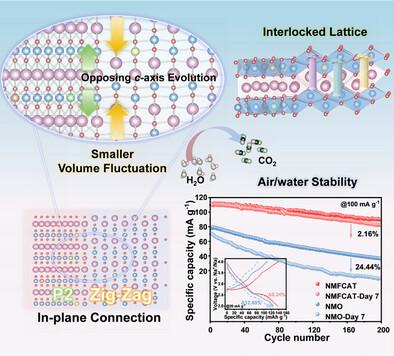Heterostructured Manganese-Based Cathode with Atomic Interlocking for Advanced Sodium-Ion Batteries
IF 26
1区 材料科学
Q1 CHEMISTRY, PHYSICAL
引用次数: 0
Abstract
Although manganese-rich layered oxides are promising as low-cost, high-capacity cathodes for sodium-ion batteries, their single-phase design suffers from structural degradation due to unfavorable phase transitions and lattice strain accumulation caused by inherent defects. To address this issue, we propose a functionally oriented multi-element doping strategy to construct a P2/Zig-Zag biphasic cathode (NMFCAT) with an atomically interlocked heterojunction. Unlike conventional biphasic systems, this in-plane connection design enables continuous Na⁺ diffusion through atomically shared phase boundaries while leveraging strain-complementary evolution to restrict volume fluctuation to 1.44% (vs 3.12% in pure P2). Crucially, the Zig-Zag motifs serve as mechanical anchors at phase boundaries, exploiting the interlocking effect to suppress interfacial separation and maintain heterojunction integrity during cycling. Concurrently, the integrated P2 phase lowers the Na+ migration barrier to 0.19 eV, synergistically enhancing electrode kinetics and air stability (only 0.05% residual alkali increase after 7-day exposure). The rationally designed NMFCAT cathode exhibits superior electrochemical performance, fast electrode kinetics, and negligible volume variation, establishing a new paradigm for multiphase structural engineering in layered Mn-based cathodes for high-performance sodium-ion batteries.

先进钠离子电池用原子互锁异质结构锰基阴极
虽然富锰层状氧化物有望成为钠离子电池的低成本、高容量阴极,但由于固有缺陷导致的不利相变和晶格应变积累,其单相设计受到结构退化的影响。为了解决这一问题,我们提出了一种功能取向的多元素掺杂策略来构建具有原子互锁异质结的P2/ z - zag双相阴极(NMFCAT)。与传统的双相系统不同,这种平面内连接设计使Na⁺能够通过原子共享的相边界连续扩散,同时利用应变互补进化将体积波动限制在1.44%(纯P2为3.12%)。至关重要的是,z形基序作为相边界的机械锚点,利用联锁效应抑制界面分离,并在循环过程中保持异质结的完整性。同时,集成的P2相将Na+迁移势垒降低至0.19 eV,协同提高电极动力学和空气稳定性(暴露7天后残留碱仅增加0.05%)。合理设计的NMFCAT阴极具有优异的电化学性能、快速的电极动力学和可忽略的体积变化,为高性能钠离子电池层状锰基阴极的多相结构工程建立了新的范例。
本文章由计算机程序翻译,如有差异,请以英文原文为准。
求助全文
约1分钟内获得全文
求助全文
来源期刊

Advanced Energy Materials
CHEMISTRY, PHYSICAL-ENERGY & FUELS
CiteScore
41.90
自引率
4.00%
发文量
889
审稿时长
1.4 months
期刊介绍:
Established in 2011, Advanced Energy Materials is an international, interdisciplinary, English-language journal that focuses on materials used in energy harvesting, conversion, and storage. It is regarded as a top-quality journal alongside Advanced Materials, Advanced Functional Materials, and Small.
With a 2022 Impact Factor of 27.8, Advanced Energy Materials is considered a prime source for the best energy-related research. The journal covers a wide range of topics in energy-related research, including organic and inorganic photovoltaics, batteries and supercapacitors, fuel cells, hydrogen generation and storage, thermoelectrics, water splitting and photocatalysis, solar fuels and thermosolar power, magnetocalorics, and piezoelectronics.
The readership of Advanced Energy Materials includes materials scientists, chemists, physicists, and engineers in both academia and industry. The journal is indexed in various databases and collections, such as Advanced Technologies & Aerospace Database, FIZ Karlsruhe, INSPEC (IET), Science Citation Index Expanded, Technology Collection, and Web of Science, among others.
 求助内容:
求助内容: 应助结果提醒方式:
应助结果提醒方式:


